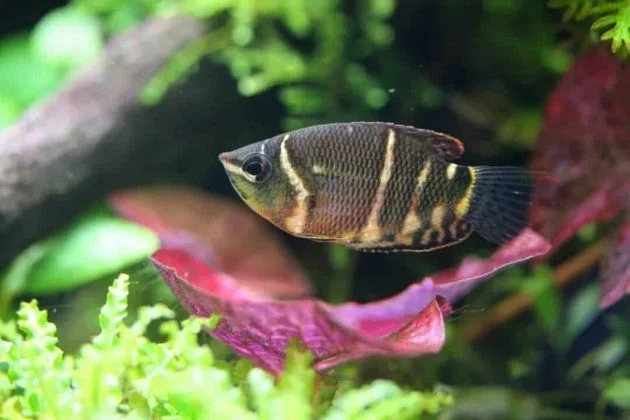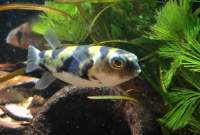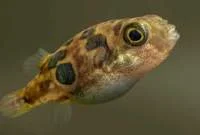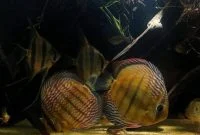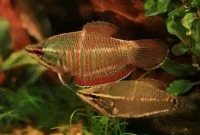Chocolate Gourami “The Unique Mouthbrooding Gourami Species” – Sphaerichthys osphromenoides, usually known as the “Chocolate Gourami,” is one of the little attractive tropical freshwater gourami fish species. These gourami types come from Borneo island, Sumatra Island, and the Malay peninsula.
Mainly they inhabit shallow blackwater peat swamps and are associated with adjacent streams of its range. Sometimes, they can also be found in clear water streams with tannin-stained, which usually has dark brown coloration from decayed organic materials. These areas commonly have heavy plant growth.
They can also be found in very acidic water streams without plants growth because it generally lows mineral content. These gourami types are enough rarely found in the trades because keeping them in the tank needs special requirements and experiences. So if you are a beginner we recommended do not try to keep them in your tank, choose another easiest and hardy gourami species to keep like dwarf gourami or honey gourami.
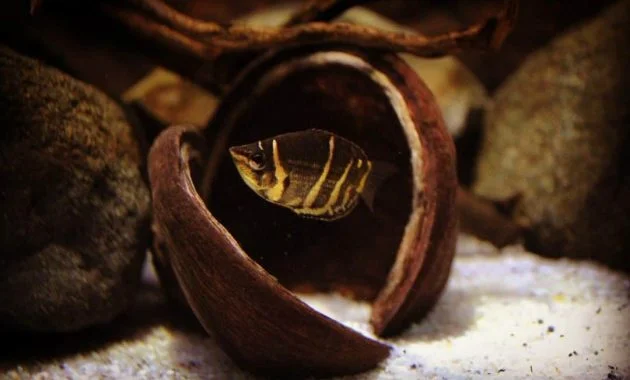
Chocolate Gourami “The Unique Mouthbrooding Gourami Species”
Chocolate Gourami Appearance
The chocolate gourami species has a small head and pointed mouth. Their body is oval-shaped and flat like other gouramis species. Their name refers to their body color that is dark chocolate brown. You may also found them with reddish-brown or greenish-brown body colors.
Another characteristic about these gouramis types, they have 3 or more yellow-white stripes that run vertically through their bodies. Their fins are longer and have yellow edging, while the caudal fins are slightly forked.
The male’s form normally is bigger overall and has fins more developed than the females. The male’s dorsal fins are more pointed, and the yellow edging at the anal and dorsal fins are more defined. The males also tend to display more reddish-brown coloration on their bodies and have straighter throats.
While the females have rounded head and throat, approximately to facilitate incubation of the eggs (mouthbrooding). Sometimes, they also developed some black spots on the caudal fins.
These chocolate gouramis can grow to reach 2.4 inches (6 cm), and their lifespan is between 6-8 years.
Read Also: The Ultimate Kissing Gourami Fish Care Sheet
Chocolate Gourami Behavior
S. osphromenoides belong to the labyrinth fish species that means they have labyrinth organ which can take the oxygens directly from the water surface. So, you see them usually swimming to the water surface to take a breath. They also tend to swim at the med-upper level in the tank, making them easily reach the surface.
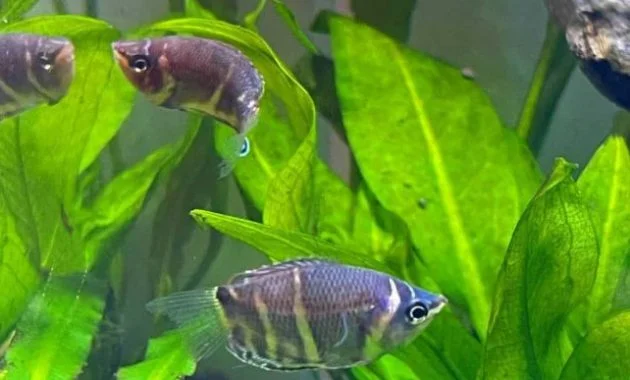
Buy Chocolate Gourami Only On eBay
This gourami fish type is slow-moving, shy, and gently fish. So, they would be terrified or defeated by other rowdy tankmates when feeding time.
They can be aggressive with each other, especially between males and another male. The larger tank will be corrected to keeping them in groups. At least six or more pieces will be good to keep them in a group, and they will be peaceful and thrive.
Read Also: Complete Tropical Pearl Gourami Fish Care Sheet
Chocolate Gourami Housing And Care
The chocolate gourami fish is quite hard to keep. These tropical fish are susceptible to skin parasites or bacterial infections if without the right water conditions. They can be housing lonely, group or community.
The minimum tank size to keep Sphaerichthys osphromenoides solo is a 30-gallon tank. You will need a larger aquarium size for keeping them in a small group or community, at least a 50-gallons tank size.
The sandy substrate like black or brown sands is a good choice to use. In their natural habitat, they tend to inhabit sluggish water or quiet environments. So, you need a filtration system that results in slow-flowing water similar to their habitat.
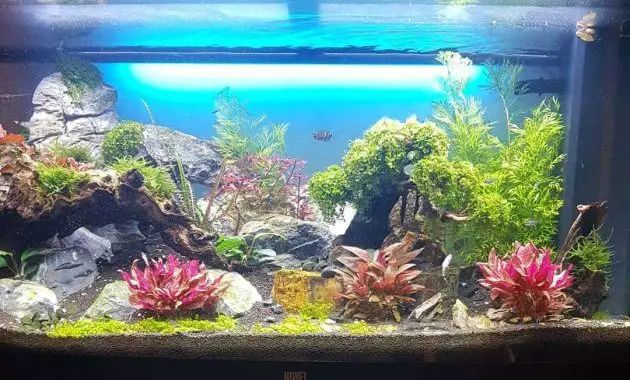
Planting some hardy freshwater aquarium plants like anubias, cryptocoryne, or taxiphyllum can survive in their environments. Adding some hardy floating plants such as Salvinia natans or Azolla cristata is allowed. It can hold the light from the aquarium lamp and make some shady areas in the tank which they prefer. However, do not cover all aquarium surfaces with floating plants. You should provide some areas for the gouramis to take the air.
Recommended using dim lighting. They will grow well in these conditions, although medium lighting is still allowed. You don’t need an aeration system, they still can survive without it, and aquatic plants in your tank are enough to produce oxygen for them.
Adding dried leaf litter like cattapa or oak can produce the tannins that give more beneficial for them. It also shows a natural feel in your tank and produces the microbe colonies as an extra food source.
Putting some driftwood, stone, or caves not only gives an aesthetic value. It also offers a hiding/chilling place for them which makes them happier and feel safe.
There are some conditions for keeping the chocolate gourami can normally live in the aquarium, that is:
- pH Level: 4.0 to 6.0
- Water Hardness Level: 0.5 to 6 dGH
- Temperature: 26 – 31 °C
Read Also: The Complete Guide To Keeping Sparkling Gourami Fish
Chocolate Gourami Feeding
These gourami fish types are categorized as omnivorous, meaning they will accept most foods. They usually feed some tiny aquatic crustaceans, zooplankton, larvae, insects, and algae in the wild.
The chocolate gourami fish also can accept dried food from pet stores. The algae-based flakes are good choices for them. However, live or frozen food is the best way to make them grow well.
Giving them daphnia, shrimp meats, micro worm, artemia, or frozen bloodworms can develop their coloration and more healthy.
Read Also: Dwarf Gourami Fish Tank Mates – List Of 9 The Best Friendly And Compatible Species
Chocolate Gourami Tankmates
It would be best if you were careful to decide on their tankmates in the aquarium because they don’t react well to disturbance and fast-mover species. When feeling disturbed, they tend to move quickly jerky, and body coloration becomes very pale.

So, you should add some quiet life and slow-moving species like danios, harlequin rasbora, or some kuhli species such as kuhli loaches and mini royal loach. Some hobbyists succeed in keeping them together with discus, which requires the same care and water conditions.
Read Also: 10 Good Reason Why You Should Have An Aquarium Fish At Your Home
Chocolate Gourami Breeding
Unlike most other gourami types, they are paternal mouthbrooders that mean they incubate the eggs in their mouth. It would be best if you prepared a breeding tank before. Feeding enough high-quality live foods to the mature chocolate gouramis before spawning is important because the female will hold the eggs for two weeks.
The water temperature should be set to 27ºC/81°F, and some breeders use daylight from the fish room window as lighting. If you using gravel as substrates should be avoided and change with fine sands.
Add some aquarium plants such as java moss or java fern freely placed for heavy cover and use standard sponge type as a filter system.
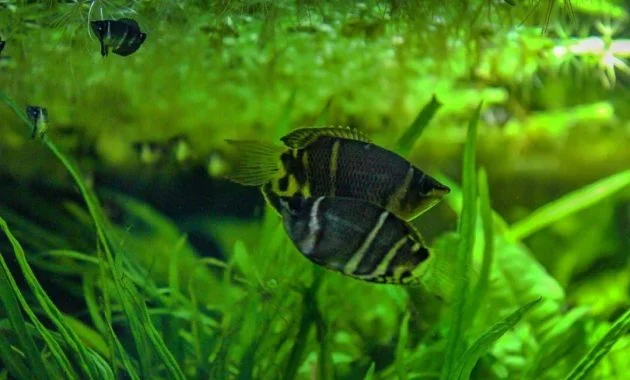
Before they spawn, the male usually developed stronger body colors and showing beside the female. When spawning begins, the male will wrap the female, such as other fish mating rituals.
The Female will lay the eggs some eggs, and at the same time, the male will fertilize the eggs. After that, the female will collect the eggs and save them in her mouth. Sometimes, the male helps her by collecting the fertilized eggs and spit them towards the female.
This process will cycle many times until the female spent all her eggs. Spawning sessions generally consist of the bottom side of the aquarium. Once the mating session is over, the female will incubate the eggs for two weeks. Females normally can produce eggs between 40-50 pieces.
At this point, the male can be moved to another tank and keep the female alone. After the fry is fully formed, the female will release them all, and she can be moved to a separate tank to avoid predation.
The fry can be fed with live foods like brine shrimp, artemia, or microworm. Change the water to around 10% of aquarium volume to maintain the water quality and growth rate.
Some breeders use clingfilm or plastic wrap around open areas on the upper of the aquarium to certain that humidity is excessive above the water surface. The dearth of heat, humid air that believed may end up the failure of their labyrinth organ to develop correctly.

